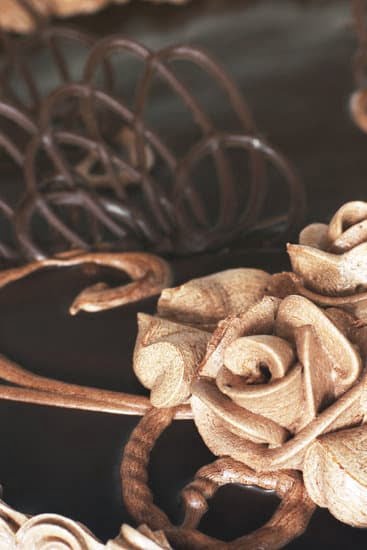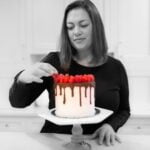When it comes to cake decorating, fondant has long been a go-to choice for achieving a pristine and polished look. However, not everyone is a fan of fondant’s taste or texture. That’s where the concept of “no fondant” cake decorating comes in. In this introductory section, we will explore what exactly no fondant cake decorating means, its benefits, and why it has become an increasingly popular alternative.
Fondant, a smooth sugar-based icing, is typically used to cover cakes and create intricate designs. While it provides a flawless finish, many find its chewy consistency less enjoyable than traditional buttercream or frosting. No fondant cake decorating offers an alternative approach that focuses on using different techniques and ingredients to achieve stunning designs without using fondant.
By embracing no fondant cake decorating, not only can you enjoy mouthwatering flavors but also have the creative freedom to experiment with various designs and textures. From elegant piped patterns to delicate frosting flowers, this technique allows for endless possibilities while still delivering professional-looking results. Whether you’re a beginner or experienced baker, exploring the world of no fondant cake decorating opens up new avenues for personal expression and culinary artistry.
In the subsequent sections of this article, we will delve deeper into the world of no fondant cake decorating. We’ll discuss the essential tools and ingredients needed for this technique, guide you through preparing your cakes for decoration, explore different techniques you can try out, provide design ideas and inspirations that showcase the beauty of no fondant decorating.
Additionally, we’ll address common mistakes and troubleshooting tips, offer best practices for storing and transporting your creations while sharing frequently asked questions (FAQs) with informative answers.
So grab your apron and pastry bags; it’s time to leave fondant behind as we dive into the deliciously artistic realm of no fondant cake decorating.
Tools and Ingredients for No Fondant Cake Decorating
No fondant cake decorating offers a creative and delicious alternative to traditional fondant-covered cakes. To successfully decorate cakes without fondant, it is important to have the right tools and ingredients at your disposal. This section will provide a list of essential tools and describe alternative ingredients commonly used in no fondant cake decorating.
When it comes to tools, there are a few key items you’ll need for successful no fondant cake decorating. Piping bags are essential for creating beautiful designs on your cakes. They come in different sizes and can be fitted with various tips to achieve different effects. Spatulas are also crucial for spreading frosting smoothly and evenly, while offset spatulas work wonders for the final touches.
In addition to piping bags and spatulas, having the right tips is important. A variety of tips can be used to create unique patterns and textures on your cakes. Some common ones include round tips for piping lines or dots, star tips for rosettes or borders, and petal tips for making flowers. Experimenting with different tips will allow you to create endless designs using just buttercream or cream cheese frosting.
Speaking of frosting, there are many alternative ingredients that can be used instead of fondant when decorating cakes. Buttercream frosting is a popular choice due to its creamy texture and versatility. It can be easily tinted with food coloring or flavored with extracts to suit any desired design or taste preference. Cream cheese frosting is another delicious option that adds a tangy twist to your creations.
Preparing the Cake for Decorating
When it comes to decorating cakes without fondant, proper preparation is essential for achieving a smooth surface and professional-looking design. In this section, we will provide a step-by-step guide on how to prepare the cake for decorating, along with some valuable tips and suggestions.
- Leveling and Stacking Cakes: Before starting the decorating process, it’s important to ensure that your cakes are level and properly stacked. This will create a sturdy foundation for your design and prevent any lopsided or uneven appearance. To level the cakes, use a long serrated knife or a cake leveler to remove any domed tops.
Make sure to work slowly and carefully to achieve an even cut. Once leveled, you can stack the layers using a thin layer of frosting in between each cake. - Crumb Coating: Crumb coating is an essential step in no fondant cake decorating as it helps seal in any loose crumbs and provides a smooth surface for the final frosting layer. To crumb coat your cake, start by applying a thin layer of frosting all over the cake using an offset spatula.
This initial layer doesn’t need to be perfect; its main purpose is to catch any loose crumbs before adding the final layer of frosting. Once the crumb coat is applied, refrigerate the cake for about 15-30 minutes to allow it to set. - Chilling or Freezing: To reduce the chances of smudging or melting your frosting while decorating, consider chilling or freezing your cake before starting the process. Chilled cakes are easier to handle and manipulate, allowing you more control over your designs.
If you choose to freeze your cake, make sure it is well wrapped in plastic wrap and placed in an airtight container to prevent freezer burn. Before working on a frozen cake, allow it to thaw in the refrigerator overnight.
By following these steps and suggestions, you can ensure that your cake is properly prepared for the decorating process. Taking the time to level and stack your cakes, crumb coat them, and chill or freeze them will contribute to a polished finish and enhance the overall appearance of your design.
| Step | Description |
|---|---|
| Leveling and Stacking Cakes | Use a serrated knife or cake leveler to level the cakes and stack them with a thin layer of frosting in between. |
| Crumb Coating | Apply a thin layer of frosting all over the cake to catch loose crumbs before refrigerating it. |
| Chilling or Freezing | Consider chilling or freezing the cake before decorating to reduce smudging or melting of frosting. |
Techniques for No Fondant Cake Decorating
No Fondant Cake Decorating offers a wide range of techniques to create beautiful and delicious cakes without using fondant. Whether you are a novice or an experienced baker, there are several techniques you can explore to achieve professional-looking designs. In this section, we will provide an overview of popular techniques for decorating cakes without fondant, detailed instructions on how to execute each technique effectively, and tips for achieving stunning results.
One popular technique in no fondant cake decorating is piping. Piping involves using a piping bag and various tips to create intricate patterns, borders, and designs on the cake’s surface. Some common piping techniques include creating rosettes, ruffles, shells, and leaves.
To pipe effectively, start by filling a piping bag with your desired frosting or buttercream and attach the desired tip. Hold the bag at a 45-degree angle and apply gentle pressure to create your desired design. Practice is key when it comes to piping, so don’t be discouraged if your first attempts are not perfect.
Another technique that can add elegance and dimension to your cake is frosting flowers. Frosting flowers involve using different tips and colors of buttercream or frosting to create realistic floral designs.
Start by choosing the appropriate tip for each flower you want to create; some commonly used tips include the petal tip for roses and the star tip for simple flowers like daisies. Begin by making small dots or lines in the center of each flower shape, then continue piping petals around the center until you achieve the desired size and shape.
Stenciling is another effective technique that allows you to add intricate designs or patterns onto your cake without using fondant. To stencil a design onto your cake, begin by securing the stencil firmly against the cake’s surface using tape or other adhesive methods.
Use a small spatula or offset spatula to spread a thin layer of frosting over the stencil, being careful not to press too hard on the stencil itself. Carefully remove the stencil, and you will be left with a beautifully stenciled design on your cake.
| Technique | Description |
|---|---|
| Piping | Using a piping bag and various tips to create intricate patterns, borders, and designs on the cake’s surface. |
| Frosting Flowers | Using different tips and colors of buttercream or frosting to create realistic floral designs on the cake. |
| Stenciling | Adding intricate designs or patterns onto the cake’s surface using a stencil and frosting. |
Design Ideas and Inspirations for No Fondant Cake Decorating
When it comes to decorating cakes without fondant, the possibilities are endless. No fondant cake decorating offers a wide range of design ideas and inspirations that can create beautiful and impressive cakes. Whether you’re looking to make a simple, elegant cake or an extravagant masterpiece, there are plenty of techniques and designs to explore.
Showcasing Various Cake Designs
One of the great things about no fondant cake decorating is the ability to create stunning designs using alternative frosting options such as buttercream or cream cheese frosting. These frostings can be used to pipe intricate designs or create smooth finishes on your cakes. For a classic look, consider piping buttercream rosettes on a two-tiered cake. This design adds elegance and sophistication to any occasion.
If you’re feeling more adventurous, try creating a watercolor effect using buttercream frosting. This technique involves blending different shades of colored frosting together to achieve a beautiful ombre effect on your cake. It’s perfect for birthdays, weddings, or any celebration where you want to add a touch of whimsy.
Themed Cakes and Occasions
No fondant cake decorating can shine in themed cakes for various occasions. For example, if you’re making a beach-themed cake, use crushed graham crackers to simulate sand on the sides of the cake and decorate with edible seashells made from chocolate molds or piped shapes using royal icing.
For children’s birthdays, consider creating a character-themed cake using only frosting techniques and edible decorations. You can create beloved characters like animals or superheroes by using buttercream piping techniques or sculpting elements out of colorful candies like M&Ms or licorice ropes.
Adapting Traditional Fondant Designs
No fondant cake decorating doesn’t mean you have to give up on popular fondant designs. Many fondant design elements can be adapted to be created using alternative frostings and techniques. For example, instead of covering a cake with fondant stripes, you can achieve the same effect by piping parallel lines of buttercream frosting.
If you want to create a textured look similar to fondant ruffles or frills, try using buttercream and a petal tip. With gentle upward strokes, pipe rows of ruffles on the sides of your cake for an elegant and feminine touch. The possibilities are truly endless when it comes to adapting traditional fondant designs to a no fondant approach.
By exploring different design ideas and inspirations for no fondant cake decorating, you’ll discover that there are countless ways to create beautiful cakes without the use of fondant. Whether you’re going for a classic or contemporary look, themed cakes or character designs, there’s something for everyone in the world of no fondant cake decorating. So go ahead, let your imagination run wild and create your own masterpiece.
Troubleshooting and Common Mistakes in No Fondant Cake Decorating
No Fondant Cake Decorating is a popular trend in the world of cake decorating that allows for beautiful and intricate designs without the use of fondant. However, beginners may encounter some challenges or make common mistakes when attempting this technique. It is important to identify these potential pitfalls and learn strategies for troubleshooting and achieving better results.
One common mistake that beginners may make in no fondant cake decorating is having inconsistent piping consistency. Piping consistency refers to the thickness or thinness of your frosting or icing, which can greatly impact the outcome of your design. If your piping consistency is too thick, it may be difficult to achieve clean lines and smooth textures. On the other hand, if your piping consistency is too thin, your design may be runny and lack definition.
To avoid this mistake, it is important to pay attention to the texture of your frosting or icing before piping. If it is too thick, you can add a small amount of liquid (such as milk or water) to thin it out. Conversely, if it is too thin, you can add more powdered sugar to thicken it up. It’s always best to start with a slightly thicker consistency and gradually adjust as needed.
Another common challenge in no fondant cake decorating is achieving vibrant frosting colors. Unlike fondant, which can easily be colored with gel or powder food coloring, buttercream or cream cheese frosting may not achieve vibrant colors initially. This can lead to faded or muted designs.
To overcome this challenge, you can use gel food coloring instead of liquid food coloring for richer and more concentrated colors. Start with a small amount and gradually add more until you achieve your desired hue. It’s also important to note that some colors may darken over time, so allow your frosted cake to sit for a while before making adjustments.
Design flaws are another potential pitfall in no fondant cake decorating. Without the ability to cover up imperfections with fondant, any mistakes or inconsistencies in your design may be more noticeable. This can be particularly challenging when attempting intricate or detailed designs.
To avoid design flaws, it is helpful to practice your designs on a separate surface before applying them to the cake. This will allow you to perfect your technique and ensure that you are comfortable executing the design. Additionally, using stencils or templates can help create precise and symmetrical designs. Taking your time and paying attention to detail will greatly reduce the chances of design flaws in your decorated cake.
By being aware of these common mistakes and following the suggested strategies for troubleshooting, beginners can overcome challenges and achieve better results in no fondant cake decorating. With practice and patience, the beauty and artistry of this technique can be fully embraced.
Best Practices for Storing and Transporting No Fondant Decorated Cakes
Storing and transporting no fondant decorated cakes require special care to ensure that the cake remains fresh and the design stays intact. Here are some best practices to follow:
Proper Storage
After decorating the cake, it is important to store it correctly to maintain freshness and prevent any damage to the frosting. A frosted cake should be kept in a cool, dry place away from direct sunlight. If possible, store it in a cake box or under a cake dome to protect it from dust and other contaminants.
If you live in a hot or humid climate, consider refrigerating the cake to prevent melting or smudging of the frosting. However, keep in mind that certain types of frostings, like buttercream, may develop condensation when taken out of the refrigerator. Allow the cake to come to room temperature slowly before serving.
Transportation
Transporting a decorated cake can be challenging, but with proper preparation and care, you can ensure its safe arrival at your destination. Start by placing the cake on a sturdy base like a cake board or thick cardboard covered with non-stick parchment paper.
To prevent any movement during transportation, secure the cake using dowels or wooden skewers inserted through each layer of the cake and into its base. You can also use non-slip mats between tiers if you are stacking multiple cakes.
When transporting the cake, make sure it is kept level at all times. Avoid sudden stops or turns that could cause the cake to shift or tilt. It is advisable to place the boxed cake on a flat surface such as the floor of your car rather than on top of seats where it may slide around.
Preserving and Displaying
Once you have successfully transported your no fondant decorated cake, you may need to preserve it for some time before serving or displaying it for an event. To maintain its freshness, store the cake in a refrigerator or cool room. However, be aware that certain toppings or decorations may need to be added just before serving to prevent them from becoming wilted or losing their shape.
When it comes to displaying your no fondant decorated cake, choose a designated area away from sunlight, heat sources, and drafts. Ensure that the display surface is clean and sturdy enough to support the weight of the cake. If necessary, use cake stands or pedestals to elevate and enhance the presentation of your masterpiece.
By following these best practices for storing and transporting no fondant decorated cakes, you can preserve their freshness and design integrity, ensuring that they look as beautiful when served as they did when you first completed them.
Frequently Asked Questions (FAQ)
Here are some frequently asked questions about no fondant cake decorating:
- Why should I choose to decorate cakes without fondant?
- What tools do I need for no fondant cake decorating?
- Piping bags: These come in various sizes and can be used to pipe frosting onto the cake in different shapes and patterns.
- Tips: There are many different types of piping tips available that allow you to create various designs, such as rosettes, stars, or leaves.
- Spatulas: Offset spatulas are particularly helpful for smoothing frosting or applying it evenly on the cake’s surface.
- What type of frosting should I use for no fondant cake decorating?
Decorating cakes without fondant offers several benefits. First, it provides a more enjoyable eating experience, as many people find fondant to be overly sweet and with a less appealing texture. Additionally, decorating a cake without fondant allows for greater creativity and versatility. You can achieve a wide range of designs using alternative techniques like piping, frosting flowers, and stenciling. Finally, decorating without fondant can often be quicker and more cost-effective than using fondant.
The good news is that you don’t need any special or expensive tools to decorate cakes without fondant. Some essential tools include:
Buttercream is a popular choice for no fondant cake decorating due to its smooth consistency and ability to hold shape well. It can be easily colored and flavored according to your preference. Cream cheese frosting is another delicious option known for its tangy taste and creamy texture. Both frostings work great for piping designs or creating impressive textures on the cake.
Conclusion
In conclusion, no fondant cake decorating offers a beautiful and versatile alternative to traditional fondant cakes. By embracing this technique, bakers can create stunning designs without the use of fondant, opening up a world of creativity and artistry. Throughout this article, we have explored various tools, techniques, and design ideas that can be utilized to achieve professional-looking cakes.
One of the main benefits of no fondant cake decorating is the ability to work with ingredients such as buttercream and cream cheese frosting. These alternatives not only provide delicious flavors but also enable bakers to create intricate designs using piping bags, tips, and spatulas. Additionally, by following the step-by-step guide for preparing the cake and implementing proper chilling techniques before decorating, the chances of smudging or melting frosting are minimized.
From piping to frosting flowers and stenciling, we have discussed popular techniques for achieving stunning designs on no fondant cakes. With detailed instructions and visuals provided, even beginners can confidently execute these techniques effectively. Furthermore, we have provided tips for troubleshooting common mistakes that may arise during the process and strategies for avoiding pitfalls altogether.
No fondant cake decorating allows for endless possibilities when it comes to design ideas and inspirations. Whether you are looking to create themed cakes or celebrate special occasions uniquely, this technique can easily adapt traditional fondant designs. The artistry and creativity that can be achieved without relying on fondant are truly remarkable.
Frequently Asked Questions
Can you decorate a cake without fondant?
Yes, it is absolutely possible to decorate a cake without fondant. Fondant is a popular choice for cake decoration as it provides a smooth and flawless finish, but it is not the only option available. Buttercream frosting is a classic and versatile alternative that can be used to create various designs, from simple rosettes to intricate piping details.
Additionally, ganache can also be used to cover cakes or create decorative elements. Other options include using fresh fruits, edible flowers, or even chocolate shards to add visual appeal and artistic flair to your cake.
What is a good substitute for fondant for cake decorating?
A good substitute for fondant in cake decorating is buttercream frosting. Buttercream offers a rich and creamy texture that can be easily spread on cakes and piped into different designs using different tips or cutters. The versatility of buttercream allows for endless creativity in terms of decorations such as rosettes, ruffles, borders, floral patterns, or even intricate personalized messages.
It can also be easily tinted with food coloring to achieve the desired color palette for your cake design. With its smooth appearance and delicious taste, buttercream frosting provides an excellent alternative to fondant.
What is no fondant cake?
A “no fondant” cake refers to a cake that has been decorated without using any fondant icing or covering. Instead of using fondant to achieve a sleek finish, other techniques and ingredients are utilized in the decoration process. One popular option is using buttercream frosting as mentioned earlier.
This can be spread smoothly over the surface of the cake or piped into different designs for an aesthetically pleasing look. Another approach is utilizing techniques like glazes or drizzles made from powdered sugar and various liquids like lemon juice or milk to create interesting patterns or textures on the cake’s surface. The key idea behind a “no fondant” cake is finding alternative ways to create visually appealing designs without relying on fondant icing as the primary medium of decoration.

Welcome to our cake decorating blog! My name is Destiny Flores, and I am the proud owner of a cake decorating business named Cake Karma. Our mission is to provide delicious, beautiful cakes for all occasions. We specialize in creating custom cakes that are tailored specifically to each customer’s individual needs and tastes.





